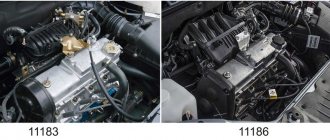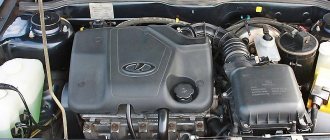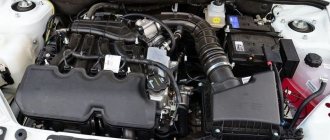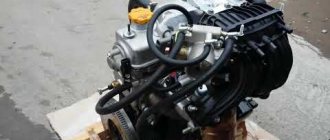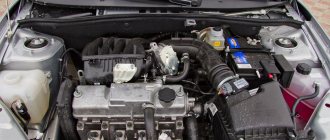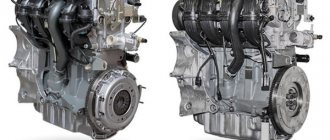I think it’s no secret that the Lada Granta is available with 4 different types of engines. And each power unit of this car has both its advantages and disadvantages. And many owners who want to buy a Grant do not know which engine to choose and which of these engines will be better for them. Below we will consider the main types of power units that are installed on this car.
VAZ 11183 - stands on the Grant “standard”
The biggest advantage of this engine is that it has a very reliable timing system and even if the timing belt breaks, the valves will not collide with the pistons, which means that you can simply change the belt (even on the road), and you can drive on. This engine is the easiest to maintain, since its design is completely identical to the well-known unit from 2108, only with an increased volume.
If you want to avoid problems with repair and maintenance, and not be afraid that the valves will bend if the belt breaks, then this choice is for you.
VAZ 21116 - set to “norm” on Grant
But in terms of dynamics, this engine outperforms a conventional 8-valve engine due to the lightweight internal combustion engine parts. And the power is about 87 hp, which is 6 horsepower more than the 21114. By the way, it works much quieter, which cannot be ignored.
VAZ 21126 and 21127 - on Grants in the “luxury” configuration
Judging by the reviews of many owners of Grants and Kalina 2, which have already had this power unit installed, the power in it has actually increased and this is felt, especially at low speeds. Although, practically no elasticity has been added and in higher gears the acceleration does not occur as quickly as we would like.
- Auto
- Lada
- Granta
- Engines
The Lada Granta was equipped with two 8-valve and two 16-valve 1.6-liter engines. Eight-valve engines with 82 and 87 hp. had an index of 11183 and 11186, respectively. Sixteen-valve power units with a capacity of 98 -106 hp. carried the index 21126 and 21127.
Lada Granta engines 16 valves
This engine is also equipped with a lightweight piston group manufactured by Federal Mogul and a belt with an automatic tensioner from Gates. It is distinguished by a 16-valve head with a pair of camshafts and hydraulic compensators, due to which its power is significantly higher.
Hatchback before restyling 2015 - 2019
| 1.6 l 21126 MKP5 | 1.6 l 21126 automatic transmission4 | |
| Type | injector | injector |
| Fuel | gasoline AI-92 | gasoline AI-92 |
| Location | transverse | transverse |
| Cylinders | 4 in a row | 4 in a row |
| valves | 16 | 16 |
| Working volume | 1596 cm³ | 1596 cm³ |
| Power | 98 hp | 98 hp |
| Torque | 145 Nm | 145 Nm |
| Acceleration to 100 km/h | 11.2 s | 13.3 s |
| Speed (max) | 182 km/h | 173 km/h |
| Ecological Class | Euro 5 | Euro 5 |
| Consumption city | 8.8 l | 9.9 l |
| Flow track | 5.6 l | 6.1 l |
| Mixed flow | 6.8 l | 7.2 l |
All the problems of its predecessors apply to this unit in full. The engine often suffers from lubricant leaks, tripping, floating speed, sensor glitches and valve burnout. Plus, you can add hydraulic compensators that are very demanding on oil quality.
All technical characteristics of the engine are described on the Motor VAZ portal
The updated engine received an adjustable intake tract with dampers in the receiver channels. Also here, the mass air flow sensor gave way to a combination of absolute pressure and air temperature sensors, thanks to which the frequent problem of floating speed at idle has finally gone away.
Hatchback before restyling 2015 - 2019
| 1.6 l 21127 MKP5 | 1.6 l 21127 AMT5 | |
| Type | injector | injector |
| Fuel | gasoline AI-92 | gasoline AI-92 |
| Location | transverse | transverse |
| Cylinders | 4 in a row | 4 in a row |
| valves | 16 | 16 |
| Working volume | 1596 cm³ | 1596 cm³ |
| Power | 106 hp | 106 hp |
| Torque | 148 Nm | 148 Nm |
| Acceleration to 100 km/h | 10.9 s | 12.3 s |
| Speed (max) | 183 km/h | 180 km/h |
| Ecological Class | Euro 5 | Euro 5 |
| Consumption city | 8.6 l | 9.0 l |
| Flow track | 5.6 l | 5.2 l |
| Mixed flow | 6.5 l | 6.5 l |
The reliability of the new unit has increased, although it is not flawless. The thermostat also often fails, the injectors become clogged, and the ignition system malfunctions. But the main threat is the water pump, because of the wedge of which the timing belt breaks and the pistons meet the valves.
Description
For the first time, the new VAZ-11186 power unit was presented to a wide range of the public in 2011. The motor was demonstrated at the Moscow Motor Show MASK in the Lada Kalina 2192.
The production of internal combustion engines is carried out at the production facilities of AvtoVAZ (Tolyatti).
The VAZ-11186 is a four-cylinder in-line naturally aspirated petrol engine with a volume of 1.6 liters and a power of 87 hp. s and a torque of 140 Nm.
Under the hood of the VAZ-11186
Installed on Lada and Datsun cars:
- Grant 2190-2194 (2011-present);
- Kalina 2192-2194 (2013-2018);
- Datsun On-Do 1 (2014-present);
- Datsun Mi-Do 1 (2015-present).
The engine is identical to its predecessor (VAZ-11183). The main difference lies in the CPG. Additionally, some assemblies and fastenings for service mechanisms have been updated.
The cylinder block remained traditionally cast iron. There are no significant structural changes.
Aluminum cylinder head. To increase strength, it is heat treated using a new process technology. The changes affected the increase in cooling channels. The head has a camshaft and eight valves.
Hydraulic compensators are not provided. The thermal clearance of the valves is adjusted manually. The combustion chamber has been increased to 30 cm³ (previously it was 26). This was achieved by reducing the thickness of the gasket and increasing the height of the cylinder head by 1.2 mm.
The pistons in the VAZ-11186 engine are lightweight and made of aluminum alloy.
On the left is a standard piston, on the right is a lightweight one
There are three rings, two of which are compression and one is oil scraper. Additional anodizing was performed in the area of the first ring, and a graphite coating was applied to the piston skirt. Piston weight 240 g. (serial – 350).
The piston configuration does not provide protection when meeting the valves in the event of a broken timing belt. But engines produced after July 2022 are free of this drawback - the pistons have become plugless. And the final touch - the VAZ-11186 piston group is completely manufactured at AvtoVAZ.
Timing belt drive, with automatic tensioner. The internal combustion engine is equipped with a Gates brand belt with an increased service life (200 thousand km). The shape of the belt cover has changed. Now it has become collapsible and consists of two parts.
On the right is the timing belt cover VAZ-11186
The automatic tension roller is also new.
On the right is a VAZ-11186 video
Receiver updated. An electromechanical throttle valve module (E-gas) is installed at its input. It is clear that the appearance of the receiver has changed.
The catcollector received separate entrances to the housing, which made it possible to reduce resistance when exhaust gases exit. In general, this contributed to a slight increase in the power of the internal combustion engine.
The generator bracket has become structurally more complex. It now has a timing belt tensioner pulley.
Engine cooling system. The heat exchanger became single-pass, the thermostat was replaced with a more advanced one. According to the manufacturer, the modification of the cooling system completely eliminated the possibility of engine overheating. (Unfortunately, on the internal combustion engine under consideration, the results of theory and practice do not always coincide).
In general, the changes implemented in the VAZ-11186 engine led to an increase in power, a decrease in exhaust toxicity and a decrease in fuel consumption.
VAZ 11183/21114
The volume of the power plant is 1.6 liters. In fact, it is a development of the old one and a half liter engine. Engineers managed to increase reliability by replacing the materials used to produce some elements and optimizing the design. If we talk about the resource, the manufacturing plant itself set the mark at 150 thousand kilometers. Practice shows that
values of 250-300 thousand are quite achievable if certain recommendations are followed. The main requirement is timely oil changes, effective heat removal will reduce wear on all engine elements. A big plus of the engine is its resistance to timing belt breaks; even in a critical situation, the likelihood of valve bending is minimal.
Service regulations for internal combustion engine VAZ 11186
According to the manufacturer's regulations, the engine oil (Rosneft Maximum 10W-40 from the factory there) and the corresponding filter are changed every 15,000 km. Also, at each maintenance check the size of the thermal clearances of the valves and, if necessary, adjust them, which entails replacing the valve cover gasket. The spark plugs, fuel and air filters here last 30,000 km. At the 90,000th mileage, the engine will undergo extensive maintenance and in addition to all the procedures described above, the ridge belt, coolant and high-voltage wires will have to be changed.
Station workers who specialize in repairing power units from the AvtoVAZ company recommend carrying out an oil service once every 10 thousand km and doing this on a warm engine. In this way, you can significantly increase the service life of the engine, which without proper maintenance and the use of high-quality consumables may require overhauls of up to 200,000 km.
Source
VAZ-21116 (87 HP)
Development of the previous model. The design improvement was aimed mainly at more efficient fuel consumption and achieving modern environmental standards. For this purpose, for example, lighter alloys were used. The negative point is a decrease in the overall strength and service life of the motor. In practice, values of 200 thousand are achievable. There is also a risk of valves bending if the timing belt breaks; its condition must be constantly monitored.
What is engine life
Each machine has a device that determines its movement. This power unit is called an engine. In turn, each motor has a certain operating life, during which no intervention in its design is required. In mechanics, this concept has a precise name - engine life.
In other words, the resource is the mileage before the onset of repair work related to the dismantling of the crankshaft of the unit. The limiting state is determined by a drop in engine power, the appearance of uncharacteristic noise during its operation (knocking, creaking, etc.) or an increase in oil and fuel consumption.
In most cases, the condition of the engine is not related to mileage. The main factors influencing the reliability of its operation are operating conditions and workmanship. An engine operated in compliance with the rules can travel hundreds of thousands of kilometers without repair.
The engines installed on the Lada Grant belong to a new generation of power units that are successfully used by domestic models. These are engines 11183 in the standard configuration, 11186/21116 in the standard configuration, and 21116 in the luxury configuration. Each of them has its own characteristics and characteristics, which need to be considered in more detail.
VAZ-21126
Grants in luxury configuration are equipped with this engine. The main difference is the modified piston group, in comparison with the previous model, its weight is approximately 30 percent less, thanks to which it was possible to achieve more power without sacrificing fuel consumption. The bending of valves due to a timing belt break and their contact with the pistons is, as before, relevant, so the condition of the drive needs to be monitored. The resource, with timely oil changes and minimal maintenance, remained at the level of 200 thousand kilometers.
Rules for operating motors
According to car owners, the biggest disadvantage in its design is the lack of an engine temperature sensor. This indicator is necessary to monitor the quality of the engine.
Overheating is the main enemy of the cylinder-piston system. The reasons for the increase in temperature in the engine may be a lack of antifreeze, insufficient cooling, etc. If the sensor is on, all of the above situations can lead to breakdown. To prevent this from happening, experts recommend installing a digital engine temperature indicator, which will accurately reflect the state of affairs.
In order to preserve the maximum resource of the engine, it is necessary to fully comply with the manufacturer’s recommendations for maintenance of the power unit.
Thus, the recommended frequency of engine checks is 15 thousand km. In this case, you do not need to wait for the indicator on the panel to inform you about any problem: it is easier to eliminate the prerequisites for a malfunction than the malfunction itself.
When the mileage reaches 30 thousand km, you will need to replace not only the oil, but also the power system filters and spark plugs, which will also be indicated by the indicator. Often, at this mileage level, the indicator begins to inform about problems in the engine. This could be a failed timing pulley or a faulty valve cover gasket. After a mileage of 45 thousand km, the indicator will indicate the need for an oil change.
If you take a responsible approach to car operation, the resource of the power unit can be increased by thousands of km.
Unqualified maintenance
Insufficient quality of air purification, or, even worse, a break in the air filter curtain will reduce the service life of the motor significantly. A heavily clogged filter will not let dirt through, but neither will air. The motor will operate in an off-design mode, and this will not extend its life.
The piston skirt and rings are covered with deep scratches - the engine clearly ran on a sand-air mixture.
The piston skirt and rings are covered with deep scratches - the engine clearly ran on a sand-air mixture.
It is important to follow the replacement intervals prescribed in the instructions. More frequent replacement is needed only in steppes and semi-deserts with their eternal dust. I advise you not to buy the cheapest filters - they can let large particles through. A good thing cannot be too cheap. It is best to buy filters from online spare parts stores.
Expert commentary
Victor Lelikov,
employee :
Spare parts for VAZ engines are in good demand. This is why there is such a high proportion of substandard spare parts on sale. Such parts come from three sources. The first is cooperative spare parts: their use is especially dangerous. For example, the service life of timing belts can be only a few tens of engine hours. The second source is still encountered defects from the official supplier. This is a spare part that did not pass VAZ technical control, but went on sale. Such parts and components destroy buyers’ faith in the reliability of VAZ cars. Finally, the third source is remanufactured engine parts. But these are becoming less and less common.
Source
Malfunctions, causes, elimination
The first drawback of Lada Granta engines, as already mentioned, is the bending of the valves when the belt breaks. To avoid this malfunction, it is necessary to change it in time and visit service centers for maintenance. Then the valves will not bend, since the updated belt will last for another 100 thousand kilometers.
Young people are trying to tune the power units of cars produced by the Lada Granta plant. This includes increasing engine power. To do this, they do chip tuning, that is, they program the electronic brains of the engine, or install a turbocharger. All this leads to the rapid depletion of the engine’s vital reserves and affects its operation. A tuned engine loses 50 thousand kilometers, which it would have covered if it had been left aspirated. And that's the minimum.
Other problems are hidden in the malfunction of hydraulic valve lifters. This is also a common malfunction that car owners have to deal with. This can only be solved by installing new hydraulic pushers.
Forgetting to regularly replace filters leads to system contamination. Crumbs from used engine parts appear and travel through the oil system. It acts as an abrasive on the pistons and wears them out. The solution to this problem is to regularly replace the filter elements, especially for oil and fuel filters.
The knocking sound of the crankshaft main bearings is a concern for car owners. In this case, you need to make sure that the oil pressure in the engine is normal. Tighten the flywheel mounting bolts.
If everything is fine with the bolts and oil, then you may have to replace the crankshaft bearings or grind the journals, or reduce the clearance in the thrust bearing. As a last resort, replace the crankshaft.
8 valve engines
Unlike 16 valves, a single-shaft gas distribution system is used here. There are two valves for each cylinder: intake and exhaust. Such engines are reliable and do not bend valves when the timing belt breaks, but are significantly inferior in the dynamic performance of the vehicle, as well as in the noise level of the internal combustion engine.
Engine VAZ 11183
This engine was installed not only on Grants, but also on the last 2114 years of production. The engine is quite noisy and requires frequent valve adjustment due to the lack of hydraulic compensators. 183 the engine does not bend the valve when the timing belt breaks. This is the only engine installed on the Grant that is not afraid of timing belt breakage.
Technical characteristics of VAZ 11183:
| Fuel supply | Injector |
| Number of cylinders | 4 |
| Number of valves | 8 |
| Compression ratio | 10 |
| Power (hp) | 82 |
| Engine capacity (cc. cm) | 1596 |
| Required fuel | Not lower than AI 95 |
| Torque (N*m) | 120 |
Engine VAZ 11186
This engine is installed in the last years of Granta production. It significantly reduced the noise characteristics and increased the compression ratio, which led to the meeting of the valves with the pistons when the timing belt breaks. Increasing the compression ratio made it possible to achieve more power from the internal combustion engine, which was beneficial for the dynamic characteristics.
Technical characteristics of VAZ 11186:
| Fuel supply | Injector |
| Number of cylinders | 4 |
| Number of valves | 8 |
| Compression ratio | 10,5 |
| Power (hp) | 90 |
| Engine capacity (cc. cm) | 1596 |
| Required fuel | Not lower than AI 95 |
| Torque (N*m) | 143 |
Two trump cards of VAZ engines
1. Cheap repairs. It is due to several factors:
- The design of the engine is familiar to almost any master.
- The tools and equipment needed for repairs are always available.
- Relatively inexpensive spare parts.
2. You can buy a new VAZ engine for a relatively small amount. An eight-valve engine will cost 40,000–50,000 rubles, and a sixteen-valve engine will cost up to 70,000 rubles. At the same time, for example, the most affordable Renault K4M engine, which is installed on the Logan, and earlier on the Lada Largus, will cost at least 104,000 rubles.
If you get defective parts
At any mileage, cylinder scuffing is possible, caused by destruction of the piston, rings, or breakage of the spark plug (an electrode or a piece of insulator has broken off). Scuffing on the cylinder surface causes loss of compression, which reduces power and causes oil burn.
If you come across fake filters or oils, the life of the engine can be very short. At high speed and rpm, the filter can burst along the rolling line, leaving the engine without oil. And simply poor filtration will reduce the life of the bearings of all shafts. Substandard oil can cause scuffing, and it can also burn so intensely that the driver can easily miss the moment when the engine is left without oil.
I advise you to purchase filters at large online spare parts stores. The likelihood of buying a fake is much lower. It is better to buy oils at well-known chain gas stations.
